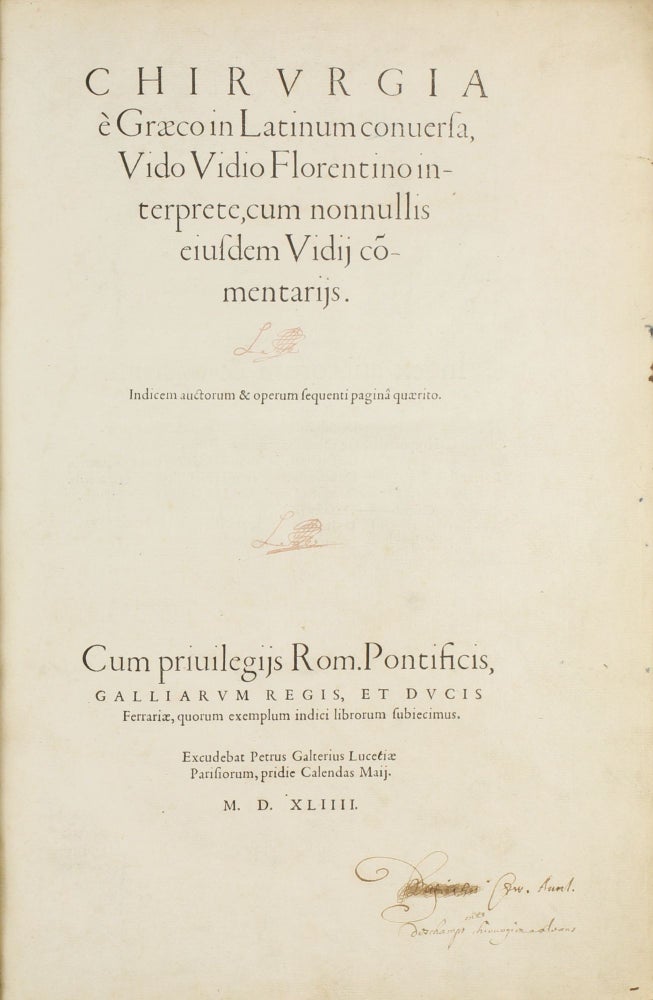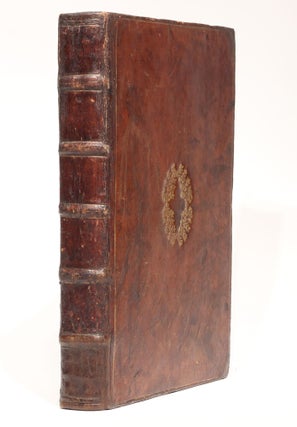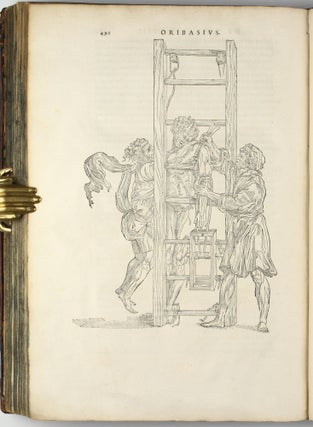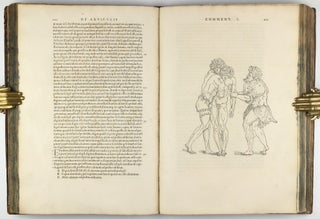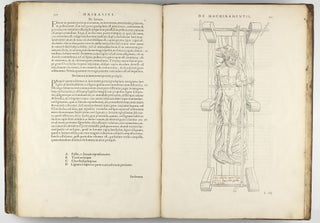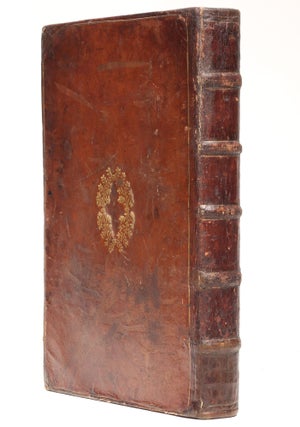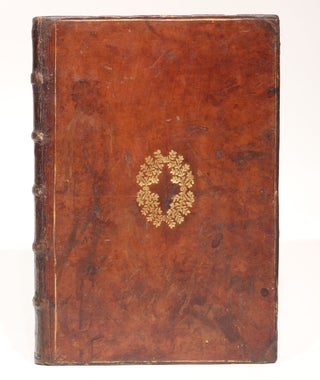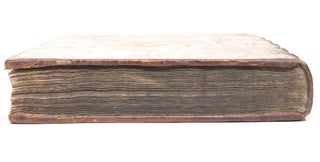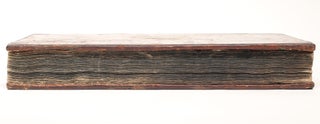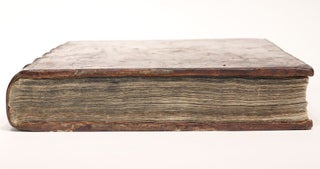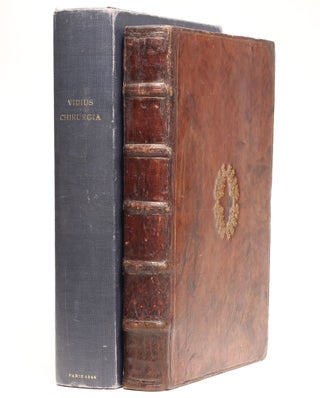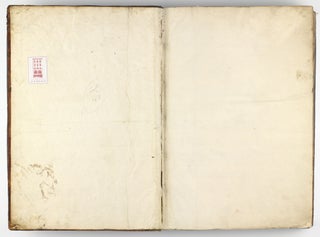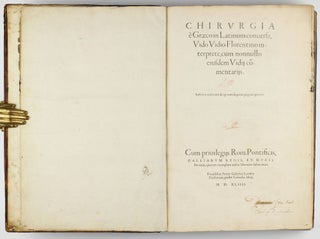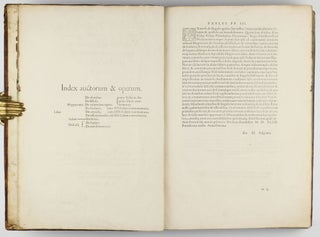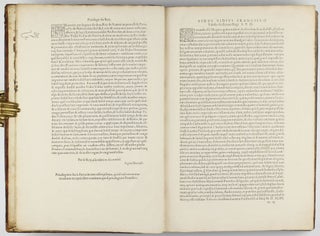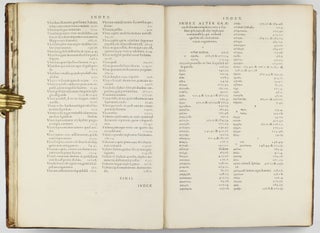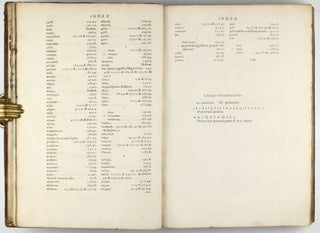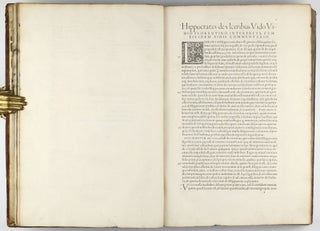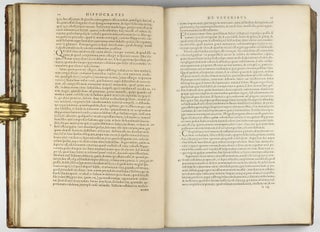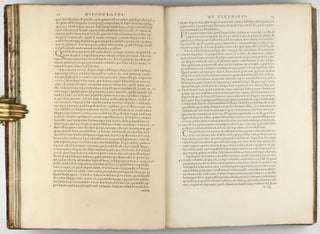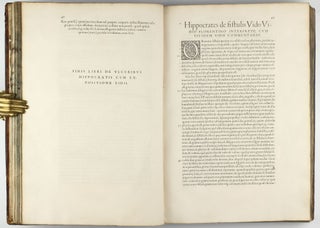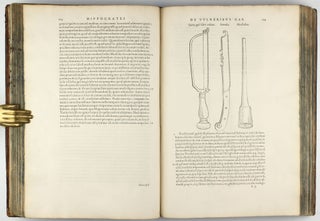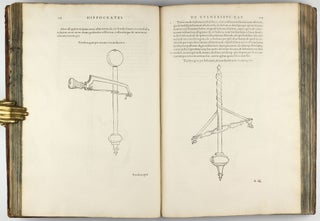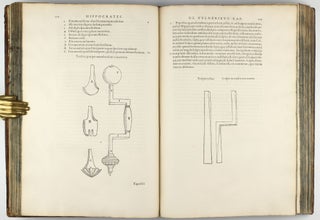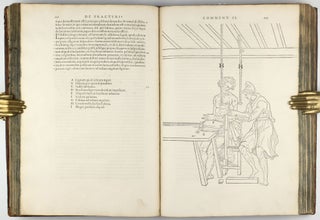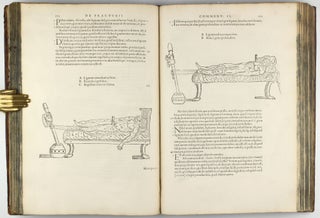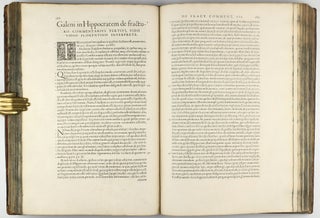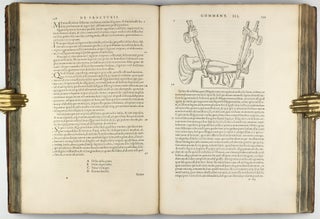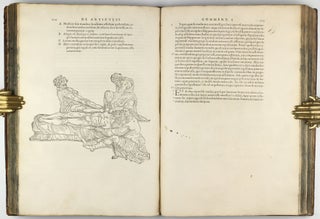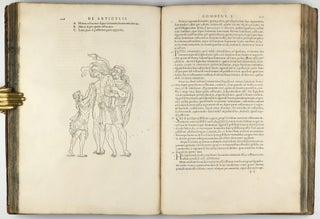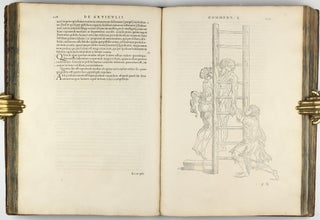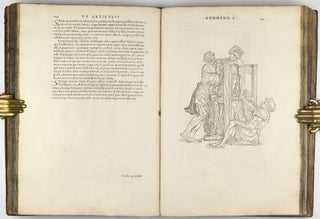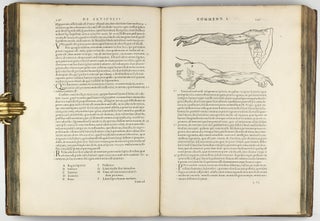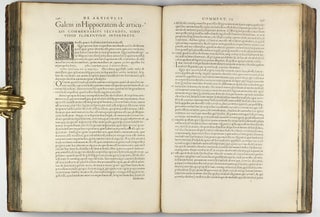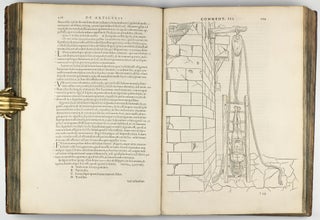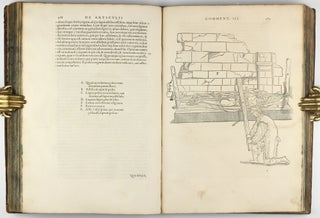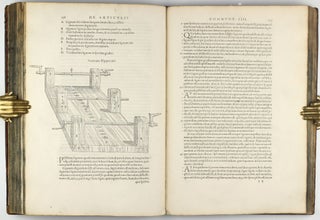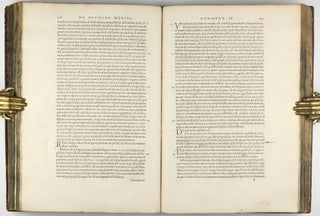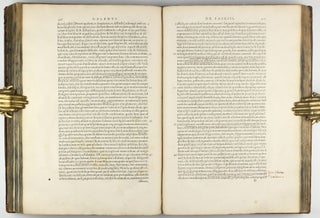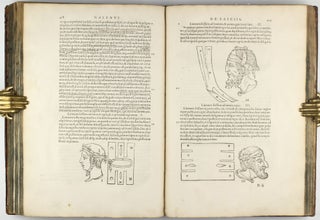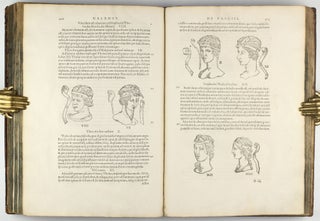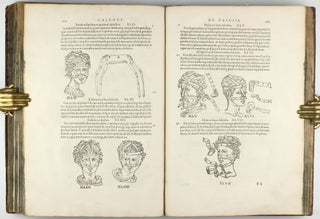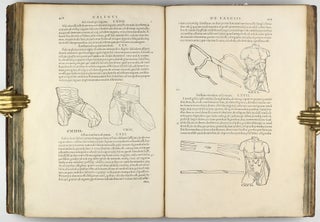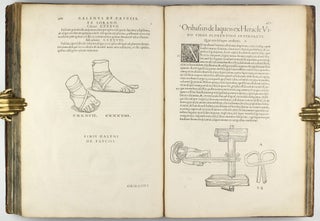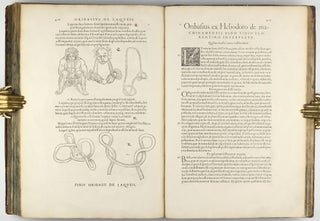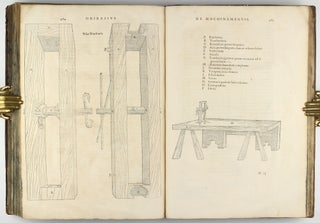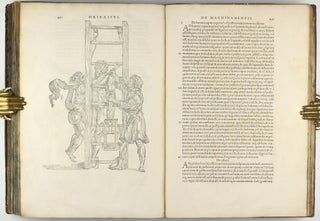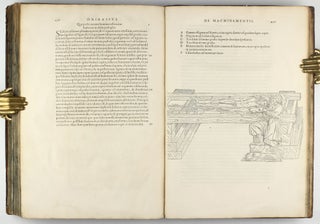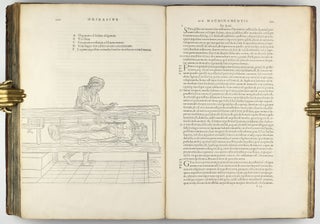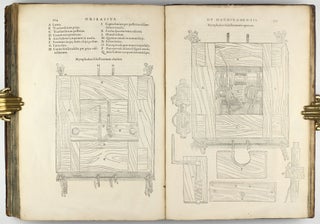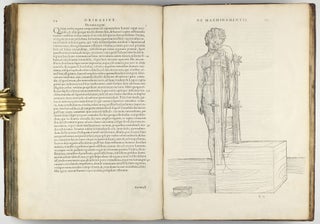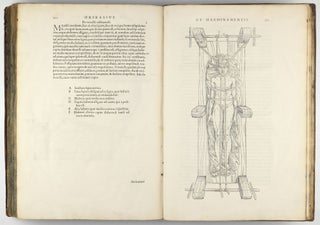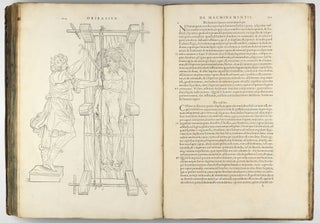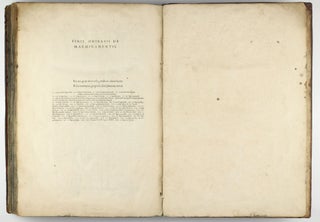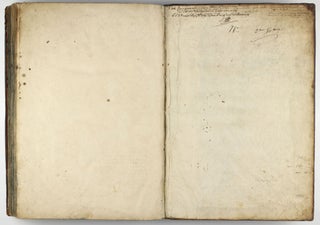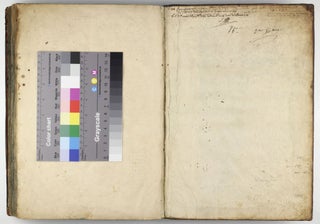One of the most beautiful scientific books of the Renaissance
Chirurgia è Graeco in Latinum conversa, Vido Vidio Florentino interprete.
Paris: Pierre Gaultier, 1544.
1st Edition. Hardcover. Very Good. Item #003675
30 April 1544. Folio (356 x 243 mm). [36], 533, [3] pp., including final blank, 210 woodcut text illustrations (of which 30 full-page), ornamental metalcut initials. Roman and Greek types. Signatures: aa8 bb10; a-z8 A-I8 K-L6. Early 17th century calf, spine with 5 raised bands, gilt-ruling of boards and spine, boards with gilt-stamped central vignette, blue-dyed edges, original endpapers (hinges, spine ends and corners expertly restored, boards scratched and edges worn). Protected in cloth clamshell box (this with some edge wear and rubbing). Text with minor browning and occasional very minor spotting, small stain in lower margin of 3 ff., minor dust-soiling to edges, finger soiling to title. Sparse annotations and text markings in contemporary ink. Provenance: Desfieches (signature on title-page); Deschamps (a surgeon of Orléans, signature on title-page); Lenormand du Coudray (paraphs in center of title); H. P. Kraus (bookplate to front pastedown "The Stock & Reference Library of H. P. Kraus"). An outstanding, tall, and unsophisticated copy. ----
RARE FIRST EDITION of Guido Guidi's translation of Nicetas' Codex into Latin. One of the most beautiful scientific books of the Renaissance, comparable only to Vesalius's De fabrica (1543) and Estienne's De dissectione (1545), this edition includes Latin translations of treatises on surgery by Hippocrates (De ulceribus, De fistulis, and De vulneribus capitis), Galen (De fracturis, De articulis, De officina medici, and De fasciis), Oribasius (De laquis and De machinamentis), and others, with commentaries by Galen and other ancient writers. Hippocrates' treatise on dislocations and Soranus' work on bandages are illustrated with woodcuts, many of them full-page, which illustrate the treatments discussed in the text. Both texts and illustrations derive from a tenth-century illustrated Greek manuscript compiled by the Byzantine physician Nicetas. Brought to Italy by Janus Lascaris in 1495, this codex (now Florence, Laur. Plut. LXXIV, 7) was used by the Florentine physician Guido Guidi for the preparation of this Latin translation. Guidi, a native of Florence and grandson of the painter Domenico del Ghirlandaio, was physician to King Francis I of France and the first professor of medicine at the Collge de France (1542-48). The woodcuts, probably by Francois Jollat, were based on drawings by Primaticcio and Jean Santorinos that were copied in turn from the tenth-century codex. These drawings survive, together with Guidi's reference to the artists, in the dedication manuscript of the translation presented to Francis I (Paris, BNF lat. 6866; see H. Omont, Collection des chirurgiens grecs avec dessins attribus au Primatice, Paris n.d.). The origin of the designs has been traced back to the first century B.C.; they were undoubtedly transmitted directly from Antiquity to Byzantium and so may be regarded as embodying the genuine Hippocratic tradition of surgical practice (H. Schne, Apollonius von Kitium, Leipzig 1896).
"In 1542, Guidi presented an illustrated copy of this manuscript, along with his own Latin translation (likewise illustrated), to Francois 1 of France [. . .] Guidi had his Latin translation printed by Pierre Gaultier, a printer residing at the castle of Benvenuto Cellini, where Guidi also lived during the time he spent in Paris. The Chirurgia was the only one of Guidi's works published during his lifetime. The exquisite woodcuts of apparatus adorning Guidi's text are copies of the drawings in Guidi's Latin manuscript, which have been claimed, on the basis of a brief reference in the manuscript, to be the work of the Italian mannerist Francesco Primaticcio (1504-1570). However, for both stylistic and logistical reasons, it is more likely that the drawings were made by the school of Francesco [Rosso] Salviati (1510-1563); [. . .] The images themselves have been traced back from the Nicetas Codex to the commentary on the Hippocratic treatise Peri arthron (On the joints) composed in the first century B.C. by Apollonius of Kitium (fl. 81-58 B.C.)" (Norman 954).
"[The images] were undoubtedly transmitted directly from antiquity, and, therefore, represent the genuine Hippocratic tradition of surgical practice" (Garrison, History of medicine, p. 125).
References and literature: Dibner 118; Norman 954; Garrison-Morton 4406.1; Heirs of Hippocrates 263; Mortimer (French) 542; NLM/Durling 2204; Wellcome I, 6596; Choulant-Frank 211 f.; Cushing G445; Osler 155; M.Hirst, Salviati illustrateur de Vidus Vidius, Revue de l'Art 6(1969), pp. 19-28; Kellett, The school of Salviati and the illustrations to the Chirurgia of Vidis Vidius, 1544, Medical history 2 (1958), pp. 264-268. Visit our website for images and further reading!
Sold
Delivery time up to 10 days. For calculation of the latest delivery date, follow the link: Delivery times
Lieferzeit max. 10 Tage. Zur Berechnung des spätesten Liefertermins siehe hier: Lieferzeiten


